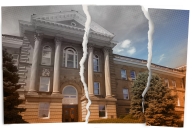You have /5 articles left.
Sign up for a free account or log in.
The State University of New York System announced this week it will begin a systemwide effort to prevent student borrowers from defaulting on their loans. The plan is the most comprehensive so far by a state higher education system to deal with the growing concern surrounding student borrowing.
Some of the steps SUNY plans to take are already in place on other campuses nationwide, such as offering net price calculator (required by federal law), and communicating early and often with borrowers (considered a best practice for averting loan defaults).
But the plan, which will be a pilot program on six campuses this year and expand to all 64 community colleges, four-year colleges and universities next fall, is believed to be the first to tackle issues of student debt and repayment systemwide.
Despite the growing national concern about whether college students are taking on too much debt, the plan won’t attempt to persuade SUNY students to borrow less, said Patricia Thompson, assistant vice chancellor for student financial aid. Over all, SUNY students graduating in 2010 borrowed about $21,700 for a bachelor's degree, close to the national average for public universities and below the average debt at graduation for students in all sectors. Instead, the system will try to prevent students from falling behind on loan payments or, in the worst-case scenario, defaulting.
The five-point plan includes creating a central online hub for borrowers to get information about their loans and expanding the system’s loan servicing center to all campuses. It also includes a previously announced plan to follow a federal template for financial aid award letters.
Policy experts say the most intriguing part of the plan is a partnership between the university and the U.S. Education Department to share data about student borrowers to see which factors correlate (and could predict) loan defaults. Using that information to create what the university describes as an “early warning system,” campus officials will be able to identify which students are at a higher risk for default and keep in touch with them throughout their college careers.
Some students, including those who are the first in their families to go to college, are already known to have a greater risk of defaulting. But the system plans to look at many other possible correlations: the total amount students are borrowing, whether they enroll in class after the semester has already started or drop a class (or several), or change majors, and whether students in certain majors or programs are more likely to default.
The system will combine data from SUNY campuses with information from the National Student Loan Data System, the government’s repository of information on loans and borrowers. At least so far, it won’t include information on private student loans, which is more difficult for colleges to access. SUNY plans to share whatever results it uncovers about factors that correlate strongly with loan default, and strategies that can be used to stave off delinquency for those students.
“We know from our data there are some students who are more likely to default, and we want to help our students who are in delinquency or default,” Thompson said. “In addition to that, we want to work to avoid students getting to that place at all.”
If the system is able to uncover some strong correlations, and work with those students to help them avoid default, that could be significant in dealing with student debt nationwide, said Daniel Hurley, director of state relations and policy analysis for the American Association for State Colleges and Universities. The rest of the SUNY plan is significant mostly because it’s an expansive, aggressive attempt by a large state system to address student debt head-on, rather than by tinkering with the college’s cost and tuition prices, Hurley said.
But the results of the data analysis could spread nationwide and affect how other colleges and universities handle their students’ borrowing. “They could probably mine, potentially, a lot of intelligence out of that partnership that could result in positive outcomes in the long term,” Hurley said.
The plan began in anticipation of the upcoming switch to tracking students’ loan defaults for three years, rather than two, which will show many more students defaulting on their loans than in the past. While defaults at SUNY will go up under the new measurement, as they will at most colleges, the rates aren't high enough to affect colleges’ eligibility for financial aid, and there is no specific target for reducing default rates with the new plan, Thompson said.
“We know we’re going to have a positive impact with these initiatives,” she said. “It’s very good, and it’s the right thing to do.”
The first results from the data-sharing won’t be available for at least a couple of years. The plan will begin on six campuses, including two community colleges, this fall, and will be expanded systemwide in 2013. Hurley said he expects that by then -- given the level of national concern about student debt, and the increased pressure from the government to ensure that students are paying back their loans -- other large universities and state systems will have rolled out efforts of their own.








